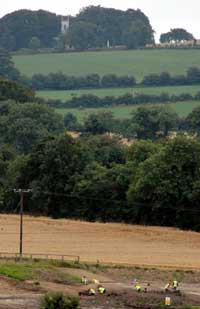6 October 2005 Edition
Defending Tara

Cnoc Teamhrach - an sean phríomhchathair
Christmas Day 1900 and on the Hill of Tara in County Meath, Maud Gonne in the company of Arthur Griffith, editor of the United Irishman and future co-founder of Sinn Féin, are inspecting recent damage done to the ancient monument site.The bizarre motivation behind the damage to the ancient seat of the High Kings of Ireland was the searching for the legendary Ark of the Covenant by a cult known as British-Israel Association of London. They believed that the Anglo-Saxon race was descended from the Lost Tribes of Israel and that consequently the British had the right to rule the world. Helped by the local landlord, the British-Israelites decided the Ark of the Covenant had been buried at Tara and must be recovered.
It was the first time that the Irish media had been involved in a campaign to protect a national monument and given the current digs for the M3 motorway, it is heartening to note the active opposition to excavating Tara.
The true heroes were patriots such as Griffith, Maud Gonne, WB Yeats and Douglas Hyde that saw Tara as a potential capital of an independent Ireland. They drew on archaeology, history and mythology in making their case to the Irish people and ultimately succeeded in mobilising public opinion and drawing a halt to the excavations.
But what is this history and mythology of Tara and why has it thus-far failed to fully ignite public opinion 100 years on when it is again threatened?
The answer lies in that degradation of Tara, which previously meant neglect, but has lately come to mean destruction. Tara is in a pitiful state unlike other sites such as Brú na Boinne (Newgrange) and the Céide Fields in Mayo.
The visitors centre lacks even public toilet facilities. Tara, at present, is the type of place which you leave feeling that you know even less about than you did when you arrived.
Did you know, for example, that Cú Chulainn's head, his sword-arm and his golden shield were taken to Tara after his last battle? Or that Na Fianna fought their final battle at Gabhra in Tara's Gabhra valley through which the M3 is planned? And that Ráth Lugh, the legendary burial place of Na Fianna, will be ten feet from the M3, on the opposite side of the M3 to Tara, severed from Tara, the place it once defended.
In more recent times 500 pikemen died at Tara in 1798. Indeed, one of the 1798 men killed in the battle of Tara was chosen as the unknown pikeman for the memorial of Tulach an tSolais on Oulart Hill, County Wexford a number of years back. Daniel O'Connell held his 750,000 person monster meeting there as part of his campaign for the repeal of the Act of Union.
This is but a fraction of Tara's lore and history which is spread out across the hill and valley of Tara and Gabhra, and which now lies in the path of the M3 motorway. One hundred years ago a friend of Griffith's wrote of those responsible for the damage at Tara: "Men have been sent to prison for less. But in Ireland there is no plank bed and hard tack for such offenders.
They sleep upon the safest mattresses in the country and feed on the fat of the land." One hundred years on and William Bulfin's comments still ring true.
While the directors at National Toll Roads (NTR) dream of a 28-acre interchange at the foot of Tara to funnel commuters onto the M3 and into the toll-booths, Irish patriots are again battling to save a national monument.
If Arthur Griffith were here today, he would be fighting to ensure that Cú Chulainn, and Na Fianna might yet be saved from turning in their graves, literally, during the Tara Gabhra valley's excavation. But Griffith isn't here now and a century later it now falls to this generation to defend Tara, ancient capital of Ireland.
Hopefully, the challenge will be met, and the M3 moved back to where it should be, with a shorter and more direct alignment west of Tara. Surely, with a little consideration the NRA can find in that shorter distance to the west between Dunshaughlin and Navan, a route where the M3 will offend only cows, and our heritage can remain just that — our heritage.
Proinsias Mac Fhearghusa lives in Meath, and is spokesperson for the Tara SOS - M3 to the West campaign. The campaign seeks to have the M3 re-routed to the west of Tara, a route which would be up to 3.5km shorter, €70m cheaper and 5km+ further away from Tara than the current M3 route.
The campaign website www.tarasos.com


